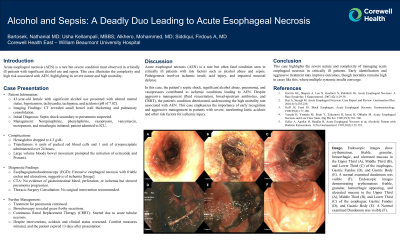Monday Poster Session
Category: Esophagus
P2304 - Alcohol and Sepsis: A Deadly Duo Leading to Acute Esophageal Necrosis
Monday, October 28, 2024
10:30 AM - 4:00 PM ET
Location: Exhibit Hall E

Has Audio

Nathanial Bartosek, MD
Beaumont Health
Royal Oak, MI
Presenting Author(s)
Nathanial Bartosek, MD1, Usha Kellampali, MBBS2, Mohammed Alkhero, MD2, Firdous Siddiqui, MD2
1Beaumont Health, Royal Oak, MI; 2Corewell Health, Royal Oak, MI
Introduction: Acute esophageal necrosis (AEN) is a rare but severe condition most commonly observed in critically ill patients with significant alcohol use and sepsis. This case illustrates the complexity and high risk associated with AEN while demonstrating its severe nature and high mortality.
Case Description/Methods: A 43-year-old female with significant alcohol use presented for altered mental status with hypotension, tachycardia, tachypnea, and acidosis with a pH of 7.02. A CT scan revealed small bowel wall thickening with a coinciding pulmonary consolidation. Septic shock secondary to pneumonia was suspected, and she was managed with norepinephrine, phenylephrine, and vasopressin with vancomycin, meropenem and micafungin and admitted to the ICU.
The patient had a significant drop in hemoglobin to 4.3 g/dL and she received six units of packed red blood cells and one unit of cryoprecipitate over the next 24 hours. She exhibited one large volume bloody bowel movement prompting the initiation of octreotide and Protonix. Esophagogastroduodenoscopy (EGD) revealed extensive esophageal necrosis with friable eschar formation and ulcerations suggestive of ischemia. A CTA did not indicate gastrointestinal bleeding, perforation, or ischemia but showed progression of pneumonia. Thoracic surgery evaluated the patient with no surgical intervention performed.
Treatment for pneumonia continued, and bronchoscopy revealed green frothy secretions. Continuous renal replacement therapy (CRRT) was employed due to acute tubular necrosis. Despite these interventions, the patient's clinical status and acidosis worsened. Comfort measures were initiated, and the patient expired thirteen days following presentation.
Discussion: Acute esophageal necrosis is a rare but often fatal condition seen in critically ill patients with risk factors like significant alcohol abuse and sepsis. The pathogenesis involves ischemic insult, acid injury, and impaired mucosal defense. In this case, the patient's septic shock and severe alcohol abuse, compounded by pneumonia and hypotension with vasopressor support, precipitated the ischemic conditions leading to AEN. Despite aggressive management, including fluid resuscitation, broad-spectrum antibiotics, and CRRT, the patient's condition deteriorated, highlighting the high mortality rate associated with AEN. This case provides needed context for early recognition and aggressive management in similar clinical contexts, especially in cases with profound, unwavering lactic acidosis.

Disclosures:
Nathanial Bartosek, MD1, Usha Kellampali, MBBS2, Mohammed Alkhero, MD2, Firdous Siddiqui, MD2. P2304 - Alcohol and Sepsis: A Deadly Duo Leading to Acute Esophageal Necrosis, ACG 2024 Annual Scientific Meeting Abstracts. Philadelphia, PA: American College of Gastroenterology.
1Beaumont Health, Royal Oak, MI; 2Corewell Health, Royal Oak, MI
Introduction: Acute esophageal necrosis (AEN) is a rare but severe condition most commonly observed in critically ill patients with significant alcohol use and sepsis. This case illustrates the complexity and high risk associated with AEN while demonstrating its severe nature and high mortality.
Case Description/Methods: A 43-year-old female with significant alcohol use presented for altered mental status with hypotension, tachycardia, tachypnea, and acidosis with a pH of 7.02. A CT scan revealed small bowel wall thickening with a coinciding pulmonary consolidation. Septic shock secondary to pneumonia was suspected, and she was managed with norepinephrine, phenylephrine, and vasopressin with vancomycin, meropenem and micafungin and admitted to the ICU.
The patient had a significant drop in hemoglobin to 4.3 g/dL and she received six units of packed red blood cells and one unit of cryoprecipitate over the next 24 hours. She exhibited one large volume bloody bowel movement prompting the initiation of octreotide and Protonix. Esophagogastroduodenoscopy (EGD) revealed extensive esophageal necrosis with friable eschar formation and ulcerations suggestive of ischemia. A CTA did not indicate gastrointestinal bleeding, perforation, or ischemia but showed progression of pneumonia. Thoracic surgery evaluated the patient with no surgical intervention performed.
Treatment for pneumonia continued, and bronchoscopy revealed green frothy secretions. Continuous renal replacement therapy (CRRT) was employed due to acute tubular necrosis. Despite these interventions, the patient's clinical status and acidosis worsened. Comfort measures were initiated, and the patient expired thirteen days following presentation.
Discussion: Acute esophageal necrosis is a rare but often fatal condition seen in critically ill patients with risk factors like significant alcohol abuse and sepsis. The pathogenesis involves ischemic insult, acid injury, and impaired mucosal defense. In this case, the patient's septic shock and severe alcohol abuse, compounded by pneumonia and hypotension with vasopressor support, precipitated the ischemic conditions leading to AEN. Despite aggressive management, including fluid resuscitation, broad-spectrum antibiotics, and CRRT, the patient's condition deteriorated, highlighting the high mortality rate associated with AEN. This case provides needed context for early recognition and aggressive management in similar clinical contexts, especially in cases with profound, unwavering lactic acidosis.

Figure: Figure: Endoscopic images show erythematous, friable, granular, hemorrhagic, and ulcerated mucosa in the Upper Third (A), Middle Third (B), and Lower Third (C) of the esophagus, Gastric Fundus (D), and Gastric Body (E). A normal examined duodenum was visible (F). Endoscopic images demonstrating erythematous friable, granular, hemorrhagic appearing, and ulcerated mucosa in the Upper Third (A), Middle Third (B), and Lower Third (C) of the esophagus; Gastric Fundus (D); and Gastric Body (E). A Normal examined Duodenum was visible (F).
Disclosures:
Nathanial Bartosek indicated no relevant financial relationships.
Usha Kellampali indicated no relevant financial relationships.
Mohammed Alkhero indicated no relevant financial relationships.
Firdous Siddiqui indicated no relevant financial relationships.
Nathanial Bartosek, MD1, Usha Kellampali, MBBS2, Mohammed Alkhero, MD2, Firdous Siddiqui, MD2. P2304 - Alcohol and Sepsis: A Deadly Duo Leading to Acute Esophageal Necrosis, ACG 2024 Annual Scientific Meeting Abstracts. Philadelphia, PA: American College of Gastroenterology.
